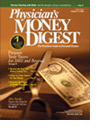Publication
Article
Physician's Money Digest
Ease Retirement with a Reverse Mortgage
Author(s):
In many common English language expressions, theterm “reverse†conjures up a less-than-positiveimage. For example, people often say they are“moving in reverse†when they're tired and feel asif they're not getting anywhere. A reverse mortgage,however, might be a different story. For many financiallyunprepared physicians, this just might be the tool toensure a good quality of life during their retirement years.
Changing Times
Today, reverse mortgages are not very popular.Some believe it's because of a lack of understanding ofhow they work, while others point to the high fees.Regardless, reverse mortgages are expected to increaseconsiderably in the years to come.
Wall Street Journal
personal finance columnistJonathan Clements points to an analysis of FederalReserve data by the AARP indicating that older babyboomers had a median household net worth of just over$146,000 in 2001. Half of that net worth was accountedfor by home equity. In forecasting a growing reliance onreverse mortgages, Clements notes that the 18,097 homeequity conversion mortgages (HECM) originated in 2003represented a 39% increase from the previous year.
The Complete Book of Money
What exactly is a reverse mortgage? Stephen Pollan,author of (Harper Collins;2000), explains that a reverse mortgage pays anolder individual or couple a tax-free income while theyremain in their home. It allows people to tap into the valueof their home, which is usually their most valuable asset,using it as collateral to help finance their golden years.
The amount of money obtainable from a reversemortgage depends on the age of the borrower, the valueof the house, and the prevailing interest rate. Pollannotes that because loan payments are based on lifeexpectancy, the older the borrower, the more money theyare likely to receive. However, loans are usually cappedat around 75% of the value of the home.
Homeowners can receive the funds from a reversemortgage in the form of one lump-sum payout or in asmaller lump sum followed by monthly payments foreither a set number of years or for the remainder oftheir life. Borrowers can also open a line of creditthrough their reverse mortgage and access funds asneeded. Because the payments received are from aloan, borrowers are not liable for any taxes. Providingthe borrower does not move or sell the home,Clements writes, the loan does not have to be repaiduntil after the borrower's death.
Cautionary Costs
There are, of course, some caveats to consider.Depending on the lender you select, your upfrontcosts could be anywhere from modest to quite steep.HECMs from the US Department of Housing andUrban Development, which accounts for approximately90% of all reverse mortgages, has the steepestupfront costs, according to Clements. That's becausethe loans are federally insured.
The other drawback to HECM reverse mortgages isthat the loans are capped between $150,896 and$280,749, depending on where the borrower lives. So,if your home is valued at more than $500,000, you willneed to consider an alternative reverse mortgage lender.
For example, Fannie Mae's Home Keeper (www.efanniemae.com) and Financial Freedom's (www.financialfreedom.com) two different cash account productsoffer considerably lower closing costs. But because theloans are not federally insured, Clements writes, youprobably won't be able to borrow as much of yourhome's value. Financial Freedom's Zero Point CashAccount has no origination fee and caps most other closingcosts at $3500, but the borrower has to draw down75% of the credit line immediately.
Clements believes that while reverse mortgages willprobably never be priced as low as conventional mortgages,closing costs could decline as this type of mortgagebecomes increasingly popular. Regardless of thecosts, if it means the difference between being comfortableor crunched in your retirement, a reverse mortgagemight be the way to go.
